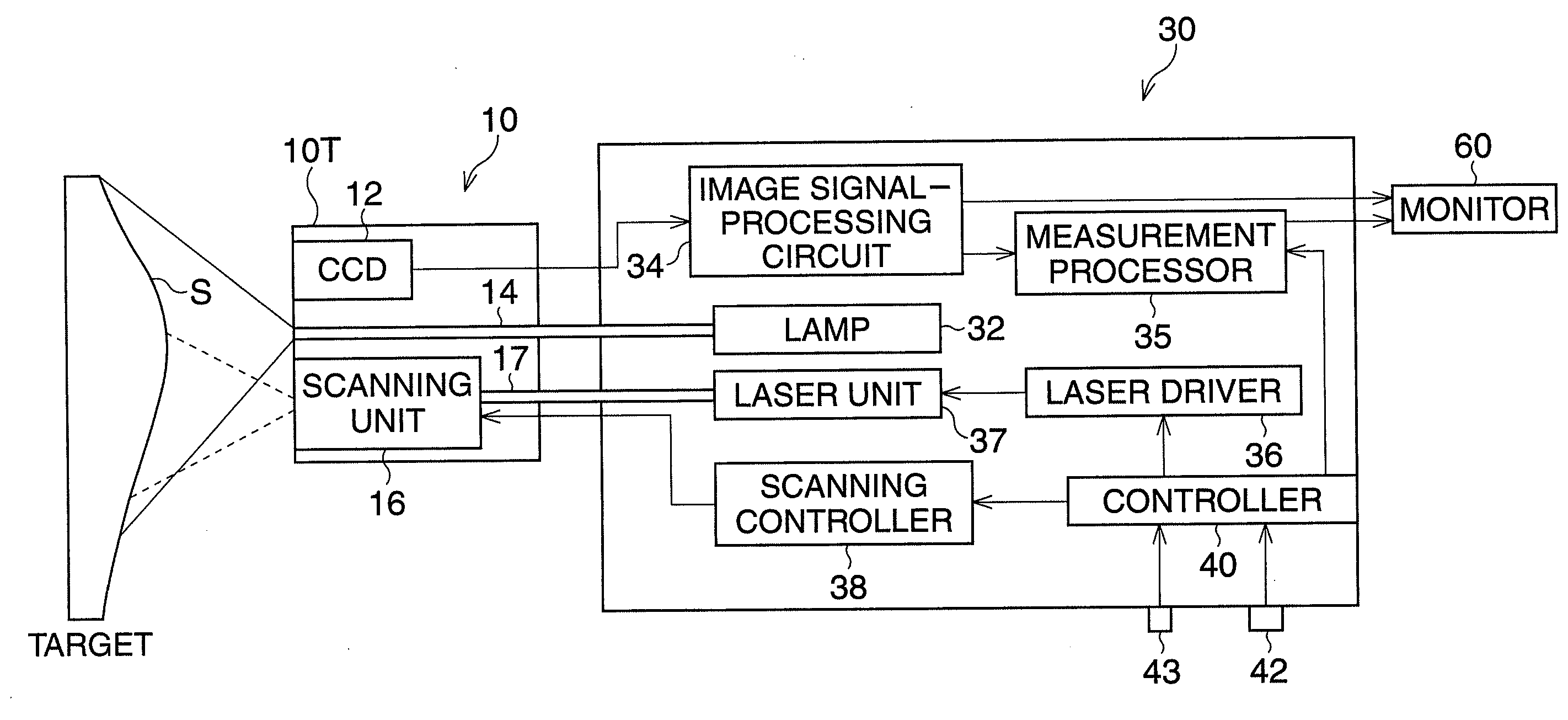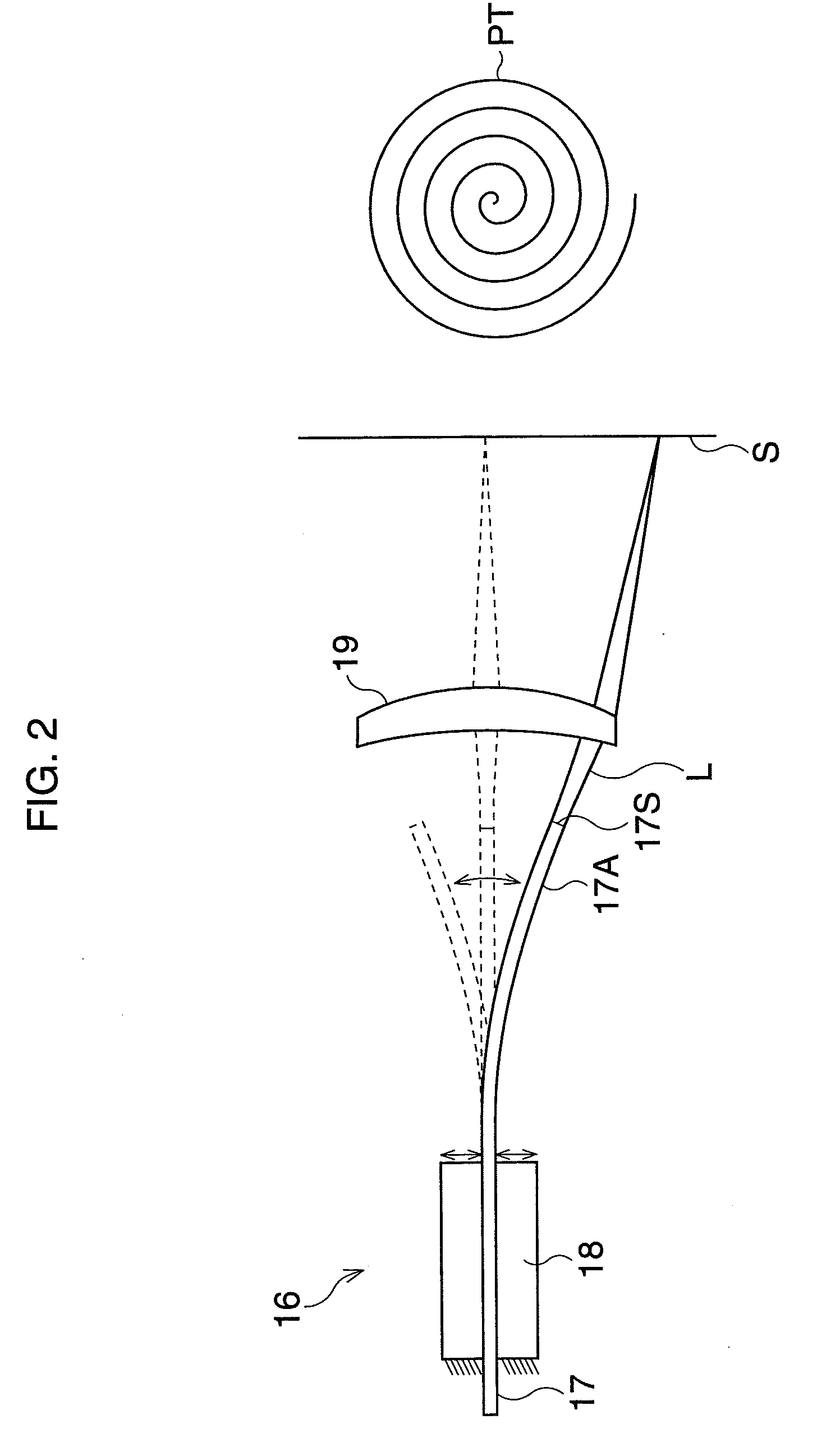Endoscope measuring 3-d profile
a technology of endoscope and three-dimensional profile, which is applied in the field of endoscope system, can solve the problems of difficult use with a general-purpose endoscope without the 3-d measurement function, and the process of calculating the 3-dimensional profile takes time, and achieves the effect of simple construction
- Summary
- Abstract
- Description
- Claims
- Application Information
AI Technical Summary
Benefits of technology
Problems solved by technology
Method used
Image
Examples
first embodiment
[0043]FIG. 1 is a block diagram of an endoscope system according to the
[0044]The endoscope system is equipped with a videoscope 10 having a CCD 12 and a processor 30. The endoscope 10 is detachably connected to the processor 40, and a monitor 60 and a keyboard (not shown) are also connected to the processor 40. An observation lamp 32, provided in the video processor 20, emits white light. The emitted light is delivered to the distal end 10T of the videoscope 10 by a light guide 14 composed of optic-fiber bundles. Light passing through the light guide 14 is cast from the distal end 10T of the videoscope 10 toward a target S.
[0045]Light reflected from the target S passes through an objective lens (not shown) and reaches the CCD 12, so that a subject image is formed on a light-receiving area of the CCD 12. On the light-receiving area of the CCD 12, a complementary color filter (not shown), checkered with a repeating pattern of the four color elements, Yellow (Y), Magenta (Mg), Cyan (Cy...
third embodiment
[0088]FIG. 13 is a block diagram according to the In the distal end 10′T of a videoscope 10′, an LCD shutter 19 composed of two-dimensionally arrayed LCDs is provided. The LCD shutter selectively passes or blocks light exiting from the optical fiber 17.
[0089]The controller 40 outputs control signals to an LCD controller 45 to synchronize the strobing of the LCD 19 with the scan timing of the scanning unit 16. The LCD 19 passes the emitted light when the scanning position is on a pattern, whereas the LCD 19 blocks the light when the scanning position is outside of the pattern. Note, any space modulation device (e.g., Digital Micro-mirror Device) other than the LCD shutter may optionally be used.
[0090]The fourth embodiment is explained with reference to FIG. 14. The fourth embodiment is different from the first embodiment in that an independent scanning system and a projection system are included. Other constructions are substantially the same as those of the first embodiment.
fourth embodiment
[0091]FIG. 14 is a block diagram of an endoscope system according to the
[0092]In a videoscope 100 having a CCD 112 and a light guide 114, a scanning system is not provided. Instead, a probe type scanning scope 200 is used. The thin scanning scope 200 has a single type optical fiber 220, and is connected to a projection unit 300. A videoprocessor 400 is equipped with a lamp 432, an image signal-processing circuit 434, a measurement processor 435, and a controller 440.
[0093]The projection unit 300 is equipped with a laser unit 320, laser driver 340, a scanning controller 360, and a system controller 380. When measuring 3-D information of a tissue, the scanning scope 200 is inserted into a forceps channel 110M provided in the videoscope 100. The tip portion of the optical fiber 220 is driven spirally by a scanning unit 240 provided in the distal end of the scanning scope 200. The system controller 380 controls the emission of light from the laser unit 320 in accordance with a pattern s...
PUM
 Login to View More
Login to View More Abstract
Description
Claims
Application Information
 Login to View More
Login to View More - R&D
- Intellectual Property
- Life Sciences
- Materials
- Tech Scout
- Unparalleled Data Quality
- Higher Quality Content
- 60% Fewer Hallucinations
Browse by: Latest US Patents, China's latest patents, Technical Efficacy Thesaurus, Application Domain, Technology Topic, Popular Technical Reports.
© 2025 PatSnap. All rights reserved.Legal|Privacy policy|Modern Slavery Act Transparency Statement|Sitemap|About US| Contact US: help@patsnap.com



